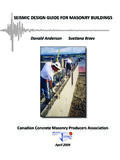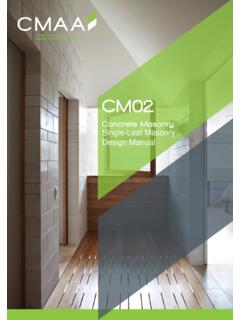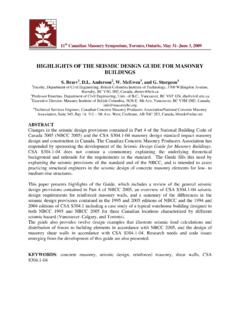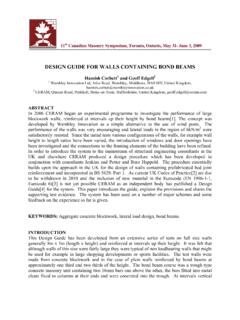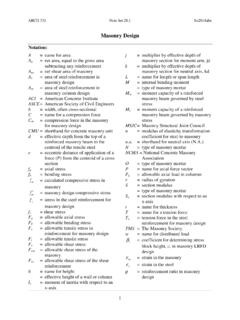Transcription of DESIGN GUIDE FOR ANCHORED BRICK VENEER
1 DESIGN GUIDE FOR ANCHORED BRICK VENEER OVER STEEL STUD SYSTEMS Prepared for: Western States Clay Products Association Submitted by: KPFF Consulting Engineers 1601 5th Ave. Suite 1600 Seattle, WA 98101 Second Edition, August 2004 ACKNOWLEDGEMENTS This report and DESIGN GUIDE was sponsored by the Western States Clay Products Association and written by KPFF Consulting Engineers. Principal-in-Charge for KPFF was Mr. Jefferson W. Asher III; Project Manager was Mr. John G. Tawresey; and Project Engineers were Mr. Edwin T. Dean and Mr. Craig Baltimore. This work was coordinated through the BRICK VENEER Sub-Committee of the Technical Commit-tee of Western States Clay Products Association. This committee consists of Mr. Jeff Elder (Chair), Mr. Jim Amrhein, Mr. Jim Anderegg, Mr. Walter Dickey, Mr. Steve Dill, and Mr.
2 Don Wakefield and Mr. Tom Welte. John G. Tawresey, KPFF Consulting Engineers prepared the 2004 Second Edition. The material presented in this publication, including technical and engi-neering data, figures, drawings and tables are for general information only. It should not under any circumstances be relied upon for specific applications of the BRICK VENEER Over Steel Stud System without inde-pendent evaluation by a licensed DESIGN professional familiar with its spe-cific use and application. Anyone making use of this material does so at their own risk and assumes any and all liability resulting from such use. Copyright 2004 by Western States Clay Products Association, All rights reserved. No part of this publication may be reproduced, stored in a computer or re-trieval system or transmitted in any form or by any means, electronic, mechanical, photocopy, fax, recording or otherwise, without the prior written consent of the author or Western States Clay Products Association.
3 TABLE OF CONTENTS DESCRIPTION Page Purpose ..1 BV/SS Definition .. 1 BV/SS Alternatives .. 2 DEFINITION .. Concept ..3 .. for Leakage .. Defense .. Configuration .. 6 Type 1 Spandrel System .. Type 2 Floor To Floor System .. Variations .. 14 14 Studs .. Sheathing .. Retarder .. Holes .. Ties .. Expansion Anchorage .. and Sealing .. CRITERIA AND PERFORMANCE .. Loads ..26 Movement .. 26 Frame .. Performance .. VENEER Structural 32 DESIGN Calculation .. 37 37 .. DESIGN Submittals .. 38 Material 38 .. 42 .. COSTS .. 48 LIST OF FIGURES/ILLUSTRATIONS DESCRIPTION Page _____ FIGURE1-1 ILLUSTRATION OF FORCESACTING TO MOVEWATERTHROUGH AN WALLSECTION FLOOR ANCHOR WALLSECTION BRICKVENEER ELEVATION OF A BRICKVENEER SLOPING MORTARJOINT SPANDREL CORNERISOLATION JOINT,FLOOR-TO-FLOOR HEADJOINTILLUSTRATION BRICK VENEER OVER STEEL STUDS KPFF Consulting Engineers 1 August 2004 INTRODUCTIONB rick masonry VENEER with a steel stud backing was first used in the late 1960's.
4 Since then, the system has proven to be a cost-effective alternative for the more tradi-tional BRICK VENEER with concrete masonry or wood stud backing. Its rapid acceptance, however, has preceded the development of adequate DESIGN and construction stan-dards. There are many examples of suc-cessful BV/SS projects. Others, however, have not performed to expectations. This BV/SS DESIGN GUIDE incorporates what has been learned from an evaluation of past system performances, both good and bad. Currently, there is no generally accepted single DESIGN and construction procedure for BRICK VENEER with a steel stud backing. A recent article warns of an unacceptable risk of failure [1]. Conflicting opinions state that the evolution of the BV/SS system is largely correcting the early problems [2], [3] & [4].
5 Yet, industry DESIGN recommendations are not always consistent1. This GUIDE seeks to address these inconsistencies and present a rational procedure for the successful de-sign and construction of BV/SS systems. Someone experienced with BRICK masonry or steel stud construction should easily un-derstand this GUIDE . It is an expansion of the prescriptive requirements of the 2003 Inter-national Building Code Uniform Building Code, Chapter 14 and the Building Code Requirements for masonry Structures, (ACI 530-02/ASCE 5-02/TMS 402-02). It begins with a description of the BV/SS system in-cluding concepts of exterior walls and their performance, various common wall configu-rations and a discussion of each wall com-_____ 1An example is the DESIGN deflection limitation on the backing wall.
6 Metal stud manufacturers recom-mend L/360. The BRICK Industry Association recom-mends L/600 ponent. Common DESIGN criteria are pre-sented and discussed followed by informa-tion on testing and wall construction. There are two levels of performance pre-sented. The basis for distinguishing be-tween levels is the anticipated system life. The first level, Level 1, is for institutional buildings with a long DESIGN life. The second level, Level 2, is for commercial buildings with an average DESIGN life. The reader familiar with BV/SS systems may find that the DESIGN recommendations here differ from current practice in some regions. DESIGN and construction practice will vary from location to location and the recommendations contained herein are not intended to transcend local experience and sound engineering judgment.
7 PURPOSE The purpose of this document is to provide the architect, structural engineer and owner with a GUIDE for the DESIGN of BRICK VENEER with a steel stud backing. BV/SS DEFINITION The BRICK Institute of America defines a ve-neer wall as: "A wall having a facing of masonry units, or other weather-resisting, non-combustible materials, securely attached to the backing, but not so bonded as to intentionally exert common action under load" and: "A BRICK VENEER wall consists of an exterior wythe of BRICK isolated from the backup by a minimum prescribed air space and attached to the backup with corrosion-resistant metal ties." BRICK VENEER OVER STEEL STUDS KPFF Consulting Engineers 2 August 2004 The International masonry Insti-tute defines a VENEER as: "A single facing wythe of ma-sonry units or similar materials securely attached to a wall for the purpose of providing orna-mentation, protection, insulation, etc.
8 But not so bonded or at-tached as to be considered as exerting common reaction under load." The 2003 International Building Code, Section 1402 defines a VENEER as: " VENEER . A facing attached to a wall for the purpose of providing ornamentation, protection or in-sulation, but not counted as adding strength to the wall. " ANCHORED masonry VENEER . VENEER se-cured with approved mechanical fastener to an approved backing." When the facing is BRICK and the backing is steel studs, the VENEER is classified as BRICK masonry VENEER with a steel stud backing, (BV/SS). Figure shows a typical BRICK VENEER on steel stud installation. Normally, the ties of the VENEER are flexible for in-plane horizontal and vertical move-ment and rigid perpendicular to the wall face. Thus, the VENEER and the backing are isolated and do not behave identically under load ("exert common action under load").
9 While the displacements perpendicular to the wall are typically the same (stiff axial tie), the vertical flexibility provided by the tie allows for differences in the response to ver-tical loading. Figure 1-1 The BRICK VENEER Over Steel Stud System BV/SSALTERNATIVES Before selecting the BV/SS system, the de-signer should consider other alternatives. One often-overlooked alternative is load bearing BRICK systems consisting of rein-forced hollow structural BRICK . These sys-tems have proven to have high load capac-ity and often are more economical than separate steel or concrete load bearing with BRICK VENEER infill. Many one-story schools have been constructed using load-bearing BRICK walls [5]. Another system is called structural BRICK ve-neer; see the DESIGN GUIDE for Structural BRICK VENEER [6].
10 This is a combination of the VENEER concepts to be described in this BRICK VENEER OVER STEEL STUDS KPFF Consulting Engineers 3 August 2004 document and structural BRICK described in Notes on the Selection, DESIGN and Con-struction of Reinforced Hollow Clay Ma-sonry [5]. The structural BRICK VENEER sys-tem may have significant advantages where geometry of the wall is complex and speed of construction is an important part of the decision criteria. Structural BRICK VENEER sys-tems can also be panelized and installed in a manner similar to precast concrete walls. BV/SS with rigid shear ties [7], or a grouted cavity have also been successfully used. The DESIGN of these systems is beyond the scope of this GUIDE . SYSTEMDEFINITION CONCEPT The DESIGN of the BV/SS system is devel-oped around several basic performance as-sumptions.

